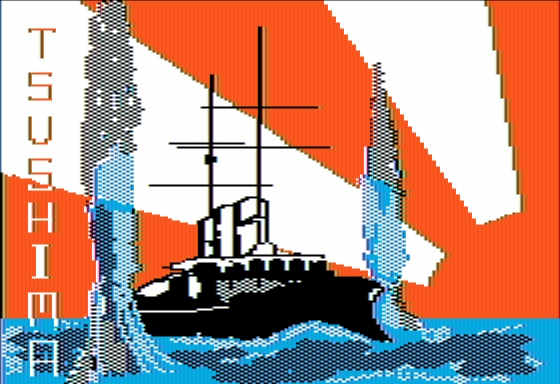Retro Replay Review
Gameplay
Tsushima delivers a deep blend of high-level decision-making and close-quarters naval combat, allowing one or two players to relive the pivotal clash between the Russian Baltic Fleet and the Imperial Japanese Navy. In strategic mode, each turn represents one hour of real time, giving you room to plot fleet maneuvers across the Straits of Tsushima. You’ll dispatch scouting ships, establish blockades and decide when to engage or evade, making every choice fraught with historical tension.
(HEY YOU!! We hope you enjoy! We try not to run ads. So basically, this is a very expensive hobby running this site. Please consider joining us for updates, forums, and more. Network w/ us to make some cash or friends while retro gaming, and you can win some free retro games for posting. Okay, carry on 👍)
When battle finally erupts, the game shifts to tactical mode: each turn now covers five minutes of intense ship-to-ship action. Positioning your cruisers and battleships becomes critical as you jockey for crossing the enemy’s “T” and unleash broadsides. The transition between strategic planning and tactical engagement feels seamless, and both layers feed into each other—losing too many ships in a firefight might doom your broader campaign.
Multiplayer enthusiasts will enjoy taking the Japanese side against a rival commander, each vying for control of chokepoints and sea lanes. Solo players can step into the shoes of the Russian admiral, racing north to Vladivostok while under constant threat. The asymmetric objectives ensure that both sides feel unique: Japan must seek and destroy, whereas Russia must slip past blockades. Balance remains remarkably tight throughout most scenarios.
Adding to the replay value, Tsushima offers scenario design tools that let you tweak forces, starting positions and victory conditions. From a brief 15-minute skirmish to an epic three-hour campaign, you choose your time commitment. Whether you want a quick taste of tactical engagements or a marathon of strategic cat-and-mouse, the game scales accordingly without sacrificing depth.
Graphics
Visually, Tsushima opts for clarity and functionality over flashy visuals, as fitting a classic Avalon Hill simulation. The board map features a textured, period-style design with clear demarcations of sea zones and straits. Each hex and coastline is labeled in a muted palette, evoking early 20th-century naval charts while ensuring readability at a glance.
Ship counters are meticulously illustrated to reflect the silhouette and firepower of each vessel class, from dreadnoughts and armored cruisers to protected cruisers and torpedo boats. Iconography for speed, armor and armament is crisp, helping you assess combat odds quickly. In tactical battles, weapon ranges are highlighted by oversize arcs, ensuring you can plan broadsides without repeatedly consulting charts.
The user interface—while minimal—places vital information within easy reach. Combat tables and range modifiers are built into pop-up panels, reducing the need to flip through rulebooks mid-game. Animations of gun smoke and shell splashes enhance immersion without overwhelming the core strategic focus. Overall, the presentation strikes a fine balance between historical flavor and streamlined usability.
Story
Tsushima’s narrative is grounded in the real-world stakes of the Russo-Japanese War of 1904–1905, culminating in the climactic Battle of Tsushima on May 27, 1905. This confrontation marked the first time an Asian power decisively defeated a European fleet in modern naval warfare, reshaping global perceptions and altering the balance of power in East Asia. The game’s structure lets you experience both the strategic pressure of a crossing fleet and the disciplined blockade tactics of the defender.
Each scenario opens with a historical briefing that outlines the geopolitical context and orders of battle, immersing you in the urgency felt by Admirals Togo and Rozhestvensky. As you issue movement orders or bring ships into line, you sense the weight of real lives and national pride on the line. These narrative elements, although concise, forge a strong connection to the past.
While Tsushima does not feature cinematic cut-scenes or fully scripted story arcs, its evolving battlefield tableau narrates a saga of industrial-era naval innovation. The ebb and flow of combat—smoke clouds drifting across the board, battered ships limping toward safety—becomes its own kind of drama. Victory or defeat carries an emotional resonance born of historical authenticity rather than digital spectacle.
Overall Experience
Tsushima stands out as a compelling wargame that balances strategic depth with accessible tactical encounters. Its dual-layer system ensures you remain invested at both the grand campaign level and the heart-pounding gunline, while scenario customization invites endless experimentation. The estimated three-hour run time for a full campaign feels substantial without overstaying its welcome.
Although the learning curve is intermediate (rated 6 of 10 on Avalon Hill’s scale), most players will find the rules well-structured and the user interface supportive. A single play-through offers enough challenge to hook dedicated strategists, while shorter tactical battles serve as ideal bite-sized introductions for newcomers. The solo mode, in particular, provides a satisfying underdog narrative as you race the Russian fleet to Vladivostok.
Whether you’re a history buff, a naval warfare enthusiast or a tabletop gamer seeking a richly detailed simulation, Tsushima delivers an engrossing experience. Its focus on authentic decision-making, coupled with clear visuals and adjustable play length, makes it a versatile addition to any game library. If you relish the thought of commanding warships under open skies and forging your own naval legend, Tsushima is well worth your time.
 Retro Replay Retro Replay gaming reviews, news, emulation, geek stuff and more!
Retro Replay Retro Replay gaming reviews, news, emulation, geek stuff and more!









Reviews
There are no reviews yet.